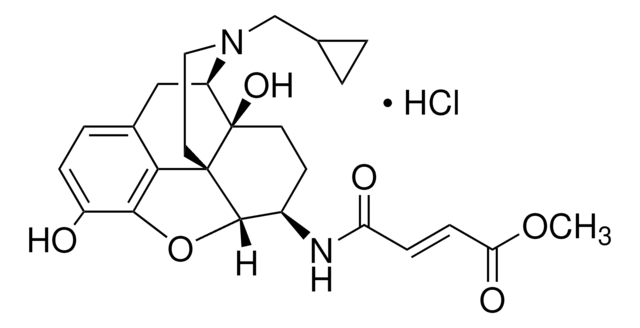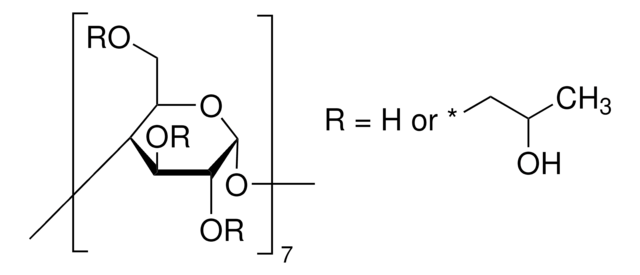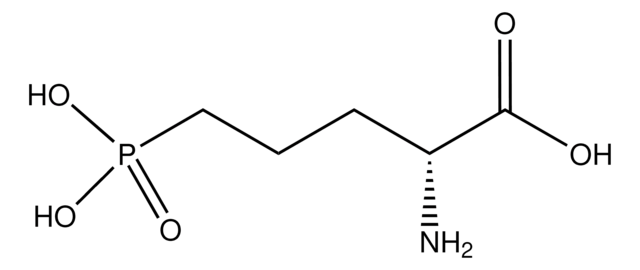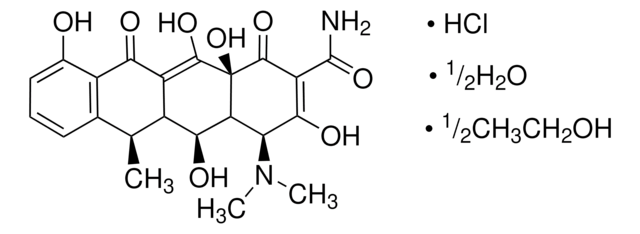SML3265
DAPTA trifluoroacetate
≥95% (HPLC)
동의어(들):
Adaptavir trifluoroacetate, D-Ala-Peptide T-NH2 trifluoroacetate, D-Ala-Peptide T-amide trifluoroacetate, Dala1-Peptide T-NH2 trifluoroacetate, Dala1-Peptide T-amide trifluoroacetate, H-D-Ala-STTTNYT-NH2 trifluoroacetate, H-D-Ala-Ser-Thr-Thr-Thr-Asn-Tyr-Thr-NH2 trifluoroacetate, [D-Ala1]-Peptide T-NH2 trifluoroacetate, [D-Ala1]-Peptide T-amide trifluoroacetate
로그인조직 및 계약 가격 보기
모든 사진(1)
About This Item
UNSPSC 코드:
51111800
NACRES:
NA.77
추천 제품
생화학적/생리학적 작용
DAPTA is a potent CCR5 antagonist, an amidated octapeptide corresponding to an HIV envelope glycoprotein gp120 (gp160)-derived sequence (aa 185-192; the SF-2 isolate) that competes against gp120-CD4 complex for interaction with CCR5 (IC50 = 0.42 nM against gp120CM235 binding to CCR5/CD4 cells, IC50 = 1.5/1.8 nM against gp120BaL/sCD4 or gp120CM235/sCD4 binding to CCR5+/CD4- cells). DAPTA blocks CCR5-dependent HIV host cell entry in cultures and in vivo.
Potent CCR5 antagonist that blocks CCR5-dependent HIV host cell entry in cultures and in vivo.
Storage Class Code
11 - Combustible Solids
WGK
WGK 3
Flash Point (°F)
Not applicable
Flash Point (°C)
Not applicable
가장 최신 버전 중 하나를 선택하세요:
Weiwei Yu et al.
Frontiers in pharmacology, 12, 551839-551839 (2021-05-07)
Background: Cigarette smoke exposure (CSE) is a major cause of chronic obstructive pulmonary disease (COPD). The smoke disrupts cell-cell adhesion by inducing epithelial barrier damage to the tight junction (TJ) proteins. Even though the inflammatory mechanism of chemokine (C-C motif)
Valeria Avdoshina et al.
AIDS (London, England), 34(7), 979-988 (2020-02-20)
Postmortem brains of patients diagnosed with HIV-1-associated neurocognitive disorders (HAND) exhibit loss of dendrites. However, the mechanisms by which synapses are damaged are not fully understood. Dendrite length and remodeling occurs via microtubules, the dynamics of which are regulated by
Ze Chen et al.
Cell death & disease, 12(2), 184-184 (2021-02-17)
The pathogenesis of bronchopulmonary dysplasia (BPD), involves inflammatory, mechanisms that are not fully characterized. Here we report that overexpression of C-C chemokine receptor 5 (CCR5) and its ligands is associated with BPD development. Lipopolysaccharide-induced BPD rats have increased CCR5 and
자사의 과학자팀은 생명 과학, 재료 과학, 화학 합성, 크로마토그래피, 분석 및 기타 많은 영역을 포함한 모든 과학 분야에 경험이 있습니다..
고객지원팀으로 연락바랍니다.








